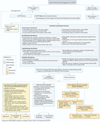Genetics and phenotyping of urological chronic pelvic pain syndrome
- PMID: 19230927
- PMCID: PMC2692547
- DOI: 10.1016/j.juro.2008.11.119
Genetics and phenotyping of urological chronic pelvic pain syndrome
Abstract
Purpose: Interstitial cystitis/painful bladder syndrome and chronic prostatitis/chronic pelvic pain syndrome, collectively renamed urological chronic pelvic pain syndromes, are a group of medically unexplained physical symptoms. Diagnosis depends on excluding all possible causes of pain and treatment targets symptoms alone. An emerging body of research implicates systemic factors in the pathogenesis of urological chronic pelvic pain syndromes including abnormal sympathetic nervous system and hypothalamic-pituitary-adrenal axis activity. Several new lines of evidence also suggest a genetic component to disease pathogenesis. Despite ongoing efforts, neither effective treatments nor mechanistic understanding of the pathogenesis of urological chronic pelvic pain syndromes exists.
Materials and methods: We performed a survey of the available literature on urological chronic pelvic pain syndromes. We reviewed recent research implicating genetic mechanisms in the development of urological chronic pelvic pain syndromes to find a systematic approach of rigorous phenotyping on which to base further investigation of these chronic pain conditions.
Results: Three studies revealed identifying genetic risk factors for disease. In addition, increasing lines of evidence of familial clustering and twin studies suggested a genetic basis for disease.
Conclusions: Given the success of genome-wide association studies in quantifying genetic risk in several polygenic diseases, we suggest a similar genome-wide approach to the study of urological chronic pelvic pain syndromes. As genome-wide association studies depend on carefully defined patient populations, we provide an outline for a thorough and multidisciplinary characterization of patient phenotypes. Although urological chronic pelvic pain syndromes continue to mystify clinicians and researchers alike, we believe the powerful new methods of unbiased interrogation of the whole genome based on systematically grouped patients possess enormous potential for progress in treating and understanding this disease.
Figures

Similar articles
-
The role of phenotyping in chronic prostatitis/chronic pelvic pain syndrome.Curr Urol Rep. 2011 Aug;12(4):297-303. doi: 10.1007/s11934-011-0196-y. Curr Urol Rep. 2011. PMID: 21533747 Review.
-
Painful Bladder Filling and Painful Urgency are Distinct Characteristics in Men and Women with Urological Chronic Pelvic Pain Syndromes: A MAPP Research Network Study.J Urol. 2015 Dec;194(6):1634-41. doi: 10.1016/j.juro.2015.05.105. Epub 2015 Jul 17. J Urol. 2015. PMID: 26192257 Free PMC article.
-
Clustering of Patients with Interstitial Cystitis/Bladder Pain Syndrome and Chronic Prostatitis/Chronic Pelvic Pain Syndrome.J Urol. 2019 Sep;202(3):546-551. doi: 10.1097/JU.0000000000000250. Epub 2019 Aug 8. J Urol. 2019. PMID: 30916629
-
Mental health diagnoses in patients with interstitial cystitis/painful bladder syndrome and chronic prostatitis/chronic pelvic pain syndrome: a case/control study.J Urol. 2008 Oct;180(4):1378-82. doi: 10.1016/j.juro.2008.06.032. Epub 2008 Aug 15. J Urol. 2008. PMID: 18707716 Free PMC article.
-
Evidence for overlap between urological and nonurological unexplained clinical conditions.J Urol. 2013 Jan;189(1 Suppl):S66-74. doi: 10.1016/j.juro.2012.11.019. J Urol. 2013. PMID: 23234637 Free PMC article. Review.
Cited by
-
Visceral and somatic pain modalities reveal NaV 1.7-independent visceral nociceptive pathways.J Physiol. 2017 Apr 15;595(8):2661-2679. doi: 10.1113/JP272837. Epub 2017 Mar 1. J Physiol. 2017. PMID: 28105664 Free PMC article.
-
Unique Microstructural Changes in the Brain Associated with Urological Chronic Pelvic Pain Syndrome (UCPPS) Revealed by Diffusion Tensor MRI, Super-Resolution Track Density Imaging, and Statistical Parameter Mapping: A MAPP Network Neuroimaging Study.PLoS One. 2015 Oct 13;10(10):e0140250. doi: 10.1371/journal.pone.0140250. eCollection 2015. PLoS One. 2015. PMID: 26460744 Free PMC article.
-
The role of phenotyping in chronic prostatitis/chronic pelvic pain syndrome.Curr Urol Rep. 2011 Aug;12(4):297-303. doi: 10.1007/s11934-011-0196-y. Curr Urol Rep. 2011. PMID: 21533747 Review.
-
Pain, catastrophizing, and depression in chronic prostatitis/chronic pelvic pain syndrome.Int Neurourol J. 2013 Jun;17(2):48-58. doi: 10.5213/inj.2013.17.2.48. Epub 2013 Jun 30. Int Neurourol J. 2013. PMID: 23869268 Free PMC article.
-
Changes in brain white matter structure are associated with urine proteins in urologic chronic pelvic pain syndrome (UCPPS): A MAPP Network study.PLoS One. 2018 Dec 5;13(12):e0206807. doi: 10.1371/journal.pone.0206807. eCollection 2018. PLoS One. 2018. PMID: 30517112 Free PMC article. Clinical Trial.
References
-
- Schaeffer AJ. Clinical practice. Chronic prostatitis and the chronic pelvic pain syndrome. N Engl J Med. 2006;355:1690. - PubMed
-
- Multi-disciplinary Approach to the Study of Chronic Pelvic Pain (MAPP) Research Network (U01) National Institutes of Diabetes and Digestive and Kidney Diseases, National Institutes of Health. [Accessed June 1, 2008]. Available at http://grants.nih.gov/grants/guide/rfa-files/RFA-DK-07-003.html.
-
- Krieger J, Nyberg L, Jr, Nickel J. NIH consensus definition and classification of prostatitis. JAMA. 1999;282:236. - PubMed
-
- Buffington CA. Comorbidity of interstitial cystitis with other unexplained clinical conditions. J Urol. 2004;172:1242. - PubMed
-
- Pontari M. Chronic prostatitis/chronic pelvic pain syndrome. Urol Clin North Am. 2008;35:81. - PubMed
Publication types
MeSH terms
Grants and funding
LinkOut - more resources
Full Text Sources
Research Materials

